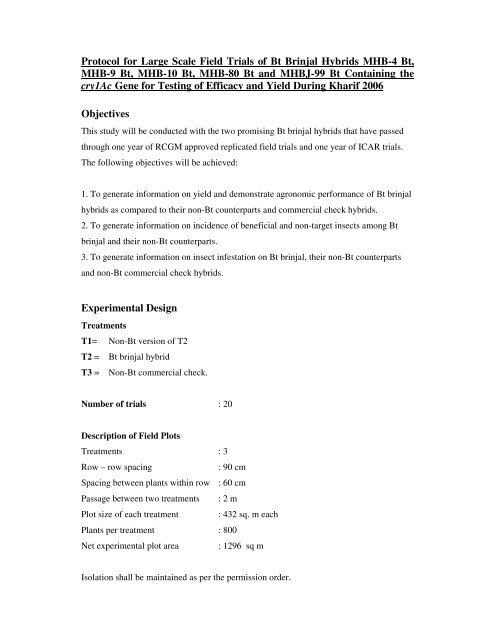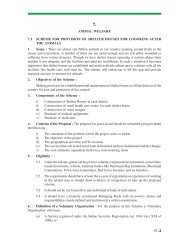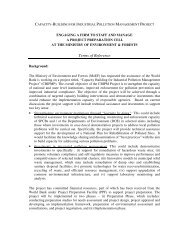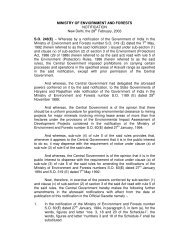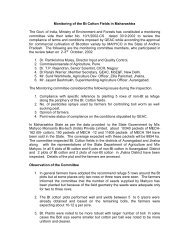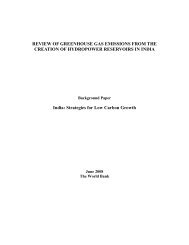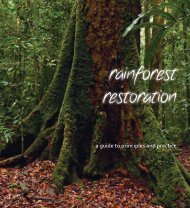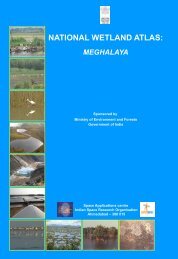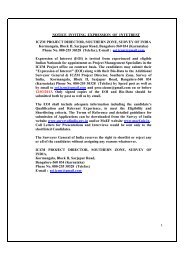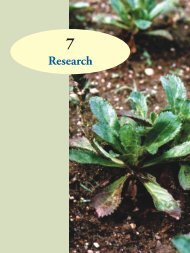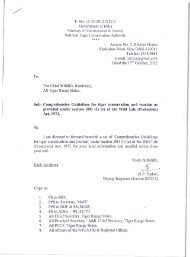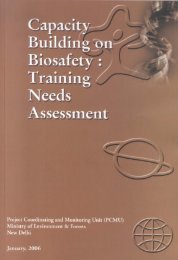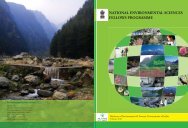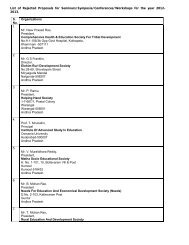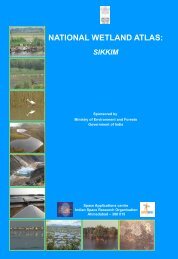Protocol for Large Scale Field Trials of Bt Brinjal Hybrids MHB-4 Bt ...
Protocol for Large Scale Field Trials of Bt Brinjal Hybrids MHB-4 Bt ...
Protocol for Large Scale Field Trials of Bt Brinjal Hybrids MHB-4 Bt ...
You also want an ePaper? Increase the reach of your titles
YUMPU automatically turns print PDFs into web optimized ePapers that Google loves.
<strong>Protocol</strong> <strong>for</strong> <strong>Large</strong> <strong>Scale</strong> <strong>Field</strong> <strong>Trials</strong> <strong>of</strong> <strong>Bt</strong> <strong>Brinjal</strong> <strong>Hybrids</strong> <strong>MHB</strong>-4 <strong>Bt</strong>,<br />
<strong>MHB</strong>-9 <strong>Bt</strong>, <strong>MHB</strong>-10 <strong>Bt</strong>, <strong>MHB</strong>-80 <strong>Bt</strong> and <strong>MHB</strong>J-99 <strong>Bt</strong> Containing the<br />
cry1Ac Gene <strong>for</strong> Testing <strong>of</strong> Efficacy and Yield During Kharif 2006<br />
Objectives<br />
This study will be conducted with the two promising <strong>Bt</strong> brinjal hybrids that have passed<br />
through one year <strong>of</strong> RCGM approved replicated field trials and one year <strong>of</strong> ICAR trials.<br />
The following objectives will be achieved:<br />
1. To generate in<strong>for</strong>mation on yield and demonstrate agronomic per<strong>for</strong>mance <strong>of</strong> <strong>Bt</strong> brinjal<br />
hybrids as compared to their non-<strong>Bt</strong> counterparts and commercial check hybrids.<br />
2. To generate in<strong>for</strong>mation on incidence <strong>of</strong> beneficial and non-target insects among <strong>Bt</strong><br />
brinjal and their non-<strong>Bt</strong> counterparts.<br />
3. To generate in<strong>for</strong>mation on insect infestation on <strong>Bt</strong> brinjal, their non-<strong>Bt</strong> counterparts<br />
and non-<strong>Bt</strong> commercial check hybrids.<br />
Experimental Design<br />
Treatments<br />
T1= Non-<strong>Bt</strong> version <strong>of</strong> T2<br />
T2 = <strong>Bt</strong> brinjal hybrid<br />
T3 = Non-<strong>Bt</strong> commercial check.<br />
Number <strong>of</strong> trials : 20<br />
Description <strong>of</strong> <strong>Field</strong> Plots<br />
Treatments : 3<br />
Row – row spacing : 90 cm<br />
Spacing between plants within row : 60 cm<br />
Passage between two treatments : 2 m<br />
Plot size <strong>of</strong> each treatment : 432 sq. m each<br />
Plants per treatment : 800<br />
Net experimental plot area : 1296 sq m<br />
Isolation shall be maintained as per the permission order.
<strong>Bt</strong> <strong>Brinjal</strong>/ LST Appli. For 2 hybrids- K’06<br />
Page 2 <strong>of</strong> 4
<strong>Field</strong> Layout <strong>of</strong> Limited <strong>Field</strong> Trial<br />
36 m<br />
Note: An isolation distance <strong>of</strong> 200 meters on all sides <strong>of</strong> the trial plot shall be<br />
maintained from any other brinjal crop.<br />
Segment types <strong>for</strong> <strong>Bt</strong> brinjal hybrids<br />
Sr No. Segment Type <strong>Bt</strong> <strong>Brinjal</strong> Hybrid<br />
1<br />
Oval, Purple with white stripes, Green<br />
Non-spiny calyx<br />
<strong>MHB</strong>-11 <strong>Bt</strong><br />
2<br />
Oval, reddish purple, Green Non-spiny<br />
calyx<br />
<strong>MHB</strong>-39 <strong>Bt</strong><br />
Observations to be recorded<br />
A. Yield parameters<br />
1. Number <strong>of</strong> healthy (marketable) fruits and those damaged by borers.<br />
2. Weight <strong>of</strong> healthy (marketable) fruits and those damaged by borers.<br />
3. Economic benefits from cultivation <strong>of</strong> <strong>Bt</strong> brinjal is to be calculated based on marketable<br />
yield and cost involved in taking up the ETL based sprays and comparing with Non <strong>Bt</strong><br />
counterpart.<br />
T 1 T 2 T 3<br />
12 m 12 m 12 m<br />
40 m<br />
<strong>Bt</strong> <strong>Brinjal</strong>/ LST Appli. For 2 hybrids- K’06<br />
Page 3 <strong>of</strong> 4<br />
2 m passage
B. Insect Observations:<br />
1. Shoot Damage: Count the number <strong>of</strong> healthy shoots and number <strong>of</strong> damaged shoots<br />
due to fruit and shoot borer attack from 20 selected plants randomly in block <strong>of</strong> each<br />
treatment at 15 days interval starting from 15 DAT (Days After Transplanting).<br />
2. Fruit borer larvae: Count the number <strong>of</strong> fruit and shoot borer larvae (Leucinodes<br />
orbonalis) and fruit borer larvae (Helicoverpa armigera) on 20 selected plants<br />
randomly in block <strong>of</strong> each treatment at 15 days interval starting from 30 DAT.<br />
3. Fruit Damage: Count percent fruits damaged by borer/s on 20 selected plants<br />
randomly in block <strong>of</strong> each treatment. Count Number <strong>of</strong> fruits damaged by borers and<br />
record the weight <strong>of</strong> the fruits damaged.<br />
Dissect 20 fruits <strong>of</strong> approximately similar size from the pre-determined plants and<br />
count the total no <strong>of</strong> larvae from <strong>Bt</strong> and non-<strong>Bt</strong> fruits (Leucinodes orbonalis and<br />
Helicoverpa armigera).<br />
4. Stem borer damage (%): Count the number <strong>of</strong> stem borer infested stems from 20<br />
randomly uprooted plants in block <strong>of</strong> each treatment at the end <strong>of</strong> the cropping season.<br />
Length <strong>of</strong> the stem (cm) and length <strong>of</strong> the stem tunnelled (cm) will be recorded to<br />
calculate percent stem tunnelling.<br />
5. Non target and beneficial insect pests: Count the number <strong>of</strong> larvae/ adults <strong>of</strong> other<br />
insect pests and accordingly monitor their incidence at regular intervals.<br />
All above observations shall be taken on same 20 selected plants throughout the crop<br />
duration.<br />
Agronomic and Pest Management<br />
<strong>Trials</strong> will be managed as per prevalent agronomic practices in the region. Insecticide<br />
sprays will be taken based on the ETL <strong>of</strong> the target pest and will be given <strong>for</strong> each<br />
treatment separately. Disease management will be done by taking up recommended<br />
practices prevalent in the region. Need based sprays will be given to control sucking pests<br />
and spray records will be maintained.<br />
<strong>Bt</strong> <strong>Brinjal</strong>/ LST Appli. For 2 hybrids- K’06<br />
Page 4 <strong>of</strong> 4
ETL criteria – ETL criteria <strong>for</strong> brinjal fruit and shoot borer will be observed<br />
as under:<br />
1. Shoot damage 5%.<br />
2. Fruit damage 10%<br />
Data analysis<br />
Data will be analyzed by using the statistical procedure using - General linear model <strong>of</strong><br />
AGROBASE s<strong>of</strong>tware.<br />
Experimental Risk Management<br />
• “Recombinant DNA Safety Guidelines-1990” and “Revised Guidelines <strong>for</strong> research in<br />
transgenic plants & Toxicity and Allergenicity evaluation <strong>of</strong> transgenic seeds, plants,<br />
plant parts 1998” put in place by Government <strong>of</strong> India, would be followed strictly.<br />
• Complete account <strong>of</strong> the transgenic materials and seeds there<strong>of</strong> would be kept as per<br />
the directives given.<br />
• Only company authorized personnel and Government nominees would be permitted to<br />
visit the experimental plot and records there<strong>of</strong> shall be maintained.<br />
<strong>Bt</strong> <strong>Brinjal</strong>/ LST Appli. For 2 hybrids- K’06<br />
Page 5 <strong>of</strong> 4


